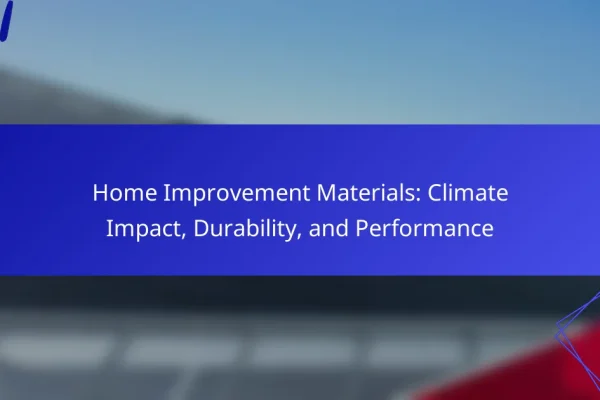What are the best durable home improvement products?
The best durable home improvement products are those that offer longevity, require minimal maintenance, and withstand environmental stressors. Key options include composite decking, vinyl siding, stainless steel appliances, quartz countertops, and fiberglass insulation.
Composite decking
Composite decking is made from a blend of wood fibers and recycled plastic, making it resistant to rot, splintering, and insects. This material typically lasts 25-30 years, significantly longer than traditional wood decking, which may require frequent staining and sealing.
When choosing composite decking, consider the color and texture options available, as well as the warranty offered by manufacturers. Look for products that have UV protection to prevent fading and ensure a longer lifespan.
Vinyl siding
Vinyl siding is a popular choice for exterior home cladding due to its durability and low maintenance requirements. It can last 20-40 years, depending on the quality and installation, and is resistant to moisture, pests, and fading.
When selecting vinyl siding, check for thickness and insulation properties, as these factors can influence energy efficiency. Ensure proper installation to avoid issues like warping or buckling over time.
Stainless steel appliances
Stainless steel appliances are known for their resistance to rust, stains, and corrosion, making them a durable choice for kitchens. With proper care, these appliances can last 15-20 years, often outlasting their painted counterparts.
To maintain stainless steel appliances, use non-abrasive cleaners and avoid harsh chemicals. Regularly check seals and gaskets to ensure energy efficiency and prevent breakdowns.
Quartz countertops
Quartz countertops are engineered stone surfaces that combine natural quartz crystals with resins, resulting in a highly durable material. They are non-porous, resistant to stains, and can last a lifetime with proper care.
When selecting quartz, consider the color and pattern options, as well as the thickness. Avoid exposing quartz to extreme heat or harsh chemicals to maintain its appearance and integrity.
Fiberglass insulation
Fiberglass insulation is an effective material for thermal and acoustic insulation, known for its durability and resistance to moisture. It can last over 50 years if properly installed and maintained, making it a long-term investment for energy efficiency.
When installing fiberglass insulation, ensure proper sealing and air barriers to maximize its effectiveness. Check local building codes for regulations regarding insulation types and R-values to ensure compliance and optimal performance.
How do durability ratings affect product selection?
Durability ratings are crucial for selecting home improvement products as they indicate how well a product can withstand wear and tear over time. Understanding these ratings helps consumers make informed decisions, ensuring they invest in products that will last and perform effectively.
Understanding durability ratings
Durability ratings typically assess a product’s resistance to damage, environmental factors, and overall lifespan. Common metrics include material strength, weather resistance, and maintenance requirements. For example, a flooring product may have a rating based on its ability to resist scratches and stains.
Different industries may use various standards for durability ratings. For instance, the American Society for Testing and Materials (ASTM) provides guidelines for construction materials, while the National Wood Flooring Association (NWFA) has specific criteria for wood products. Familiarizing yourself with these standards can aid in making better choices.
Impact on long-term costs
Investing in products with higher durability ratings can lead to significant long-term savings. While these products may have a higher upfront cost, their longevity often reduces the need for frequent replacements and repairs. For instance, high-quality roofing materials might cost more initially but can last decades longer than cheaper alternatives.
Additionally, durable products often require less maintenance, further decreasing overall expenses. Homeowners should consider the total cost of ownership, which includes purchase price, maintenance, and replacement costs, when evaluating products. A durable option may provide better value over time, making it a wise investment.
What factors influence the longevity of home improvement products?
The longevity of home improvement products is primarily influenced by material quality, environmental conditions, and maintenance practices. Understanding these factors can help homeowners make informed choices that enhance durability and extend the lifespan of their investments.
Material quality
Material quality is a crucial determinant of how long home improvement products will last. High-quality materials, such as solid wood or stainless steel, generally offer better durability compared to lower-grade alternatives like particleboard or plastic. Investing in reputable brands that adhere to industry standards can significantly improve product longevity.
When selecting materials, consider their resistance to wear, moisture, and pests. For instance, pressure-treated wood is often used for outdoor projects due to its enhanced resistance to rot and insects, making it a better choice than untreated wood.
Environmental conditions
Environmental conditions play a significant role in the lifespan of home improvement products. Factors such as humidity, temperature fluctuations, and exposure to sunlight can accelerate wear and tear. For example, products used in coastal areas may experience corrosion more quickly due to saltwater exposure.
To mitigate environmental impacts, choose products designed for specific conditions. For instance, UV-resistant paints and coatings can protect exterior surfaces from sun damage, while moisture-resistant materials are ideal for humid climates.
Maintenance practices
Regular maintenance is essential for prolonging the life of home improvement products. Simple tasks like cleaning, sealing, and inspecting can prevent minor issues from becoming major problems. For example, regularly sealing wooden decks can protect them from moisture and UV damage, extending their lifespan significantly.
Establish a maintenance schedule based on the product type and environmental conditions. For instance, outdoor furniture may require seasonal cleaning and treatment, while indoor fixtures might need less frequent upkeep. Ignoring maintenance can lead to premature deterioration and costly replacements.
How to choose the right products for your home?
Choosing the right home improvement products involves understanding your specific needs, comparing warranties, and evaluating customer reviews. This process ensures that you invest in durable and long-lasting items that meet your expectations and budget.
Assessing your needs
Begin by identifying the areas in your home that require improvement. Consider factors such as the climate, usage frequency, and aesthetic preferences. For example, if you live in a humid area, moisture-resistant materials may be essential.
Next, prioritize your needs based on functionality and longevity. Create a list of must-haves versus nice-to-haves. This will help you focus on products that provide the best value for your investment.
Comparing warranties
Warranties can provide insight into the durability of home improvement products. Look for products that offer extensive warranties, as these often indicate higher quality and manufacturer confidence. Common warranty lengths range from one year to a lifetime.
Pay attention to what the warranty covers. Some may include only defects in materials, while others cover wear and tear. Understanding the terms can help you make a more informed decision.
Evaluating customer reviews
Customer reviews are a valuable resource for assessing product performance and longevity. Look for patterns in feedback, such as common praises or complaints. This can give you a clearer picture of how a product holds up over time.
Consider the number of reviews as well; a product with a high volume of positive reviews is often more reliable than one with only a few. Use platforms that aggregate reviews to get a balanced view of customer experiences.
What are the most common maintenance practices?
The most common maintenance practices for home improvement products focus on regular upkeep to enhance durability and longevity. These practices include cleaning, inspections, and timely repairs to prevent minor issues from escalating into major problems.
Regular cleaning
Regular cleaning is essential for maintaining the appearance and functionality of home improvement products. For surfaces like siding, decks, and windows, a simple wash with mild soap and water can remove dirt and grime, helping to prevent deterioration.
Consider cleaning frequency based on your environment; areas with high pollen or dust may require monthly cleaning, while others might only need it seasonally. Always use non-abrasive materials to avoid scratching surfaces.
Seasonal inspections
Seasonal inspections help identify potential issues before they become serious. Check for signs of wear and tear, such as cracks in paint, rust on metal fixtures, or loose shingles on roofs. These inspections should be conducted at least twice a year, ideally in spring and fall.
During inspections, pay attention to areas prone to moisture accumulation, as these can lead to mold or rot. Document any findings to track changes over time and prioritize repairs accordingly.
Repairing minor damages
Addressing minor damages promptly can significantly extend the life of home improvement products. Small cracks in walls or chips in paint can often be repaired with minimal effort and cost, using fillers or touch-up paint.
For more significant issues, such as loose tiles or damaged siding, consider consulting a professional if you’re unsure about the repair process. Regularly scheduled maintenance can prevent these minor repairs from becoming costly replacements.
How do climate conditions affect product durability?
Climate conditions significantly influence the durability of home improvement products. Factors such as temperature, humidity, and exposure to sunlight can accelerate wear and tear, impacting the lifespan of materials.
Impact of humidity
Humidity levels can drastically affect the durability of various home improvement products, especially those made from wood, metal, and certain plastics. High humidity can lead to moisture absorption, causing wood to swell and warp, while metal may corrode more quickly.
When selecting materials for humid environments, consider options that are specifically designed to resist moisture. For instance, treated wood or composite materials can offer better longevity in damp conditions compared to untreated wood.
To mitigate the effects of humidity, ensure proper ventilation in areas prone to moisture, such as basements and bathrooms. Regular maintenance, including sealing and painting, can also help protect products from humidity-related damage.





